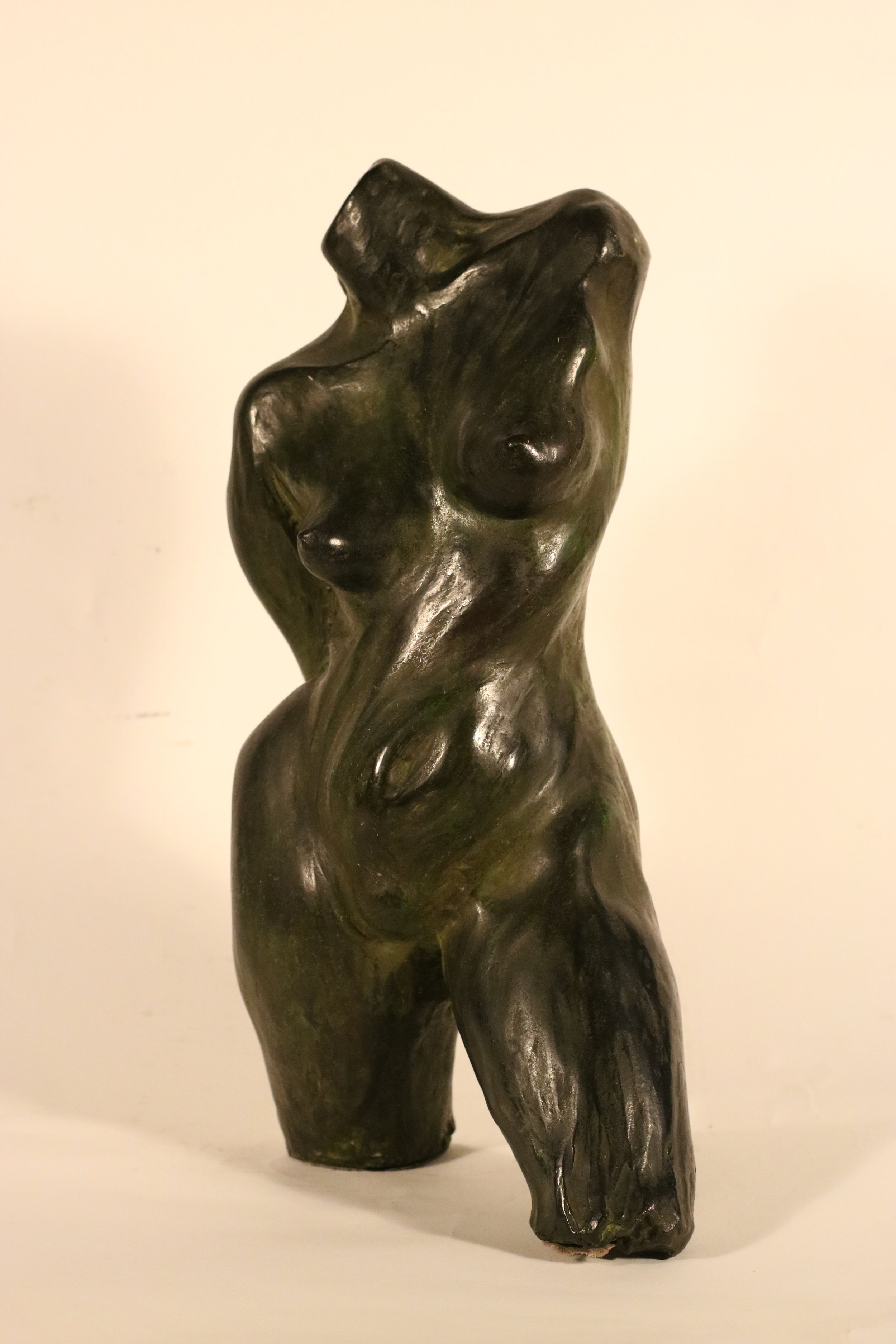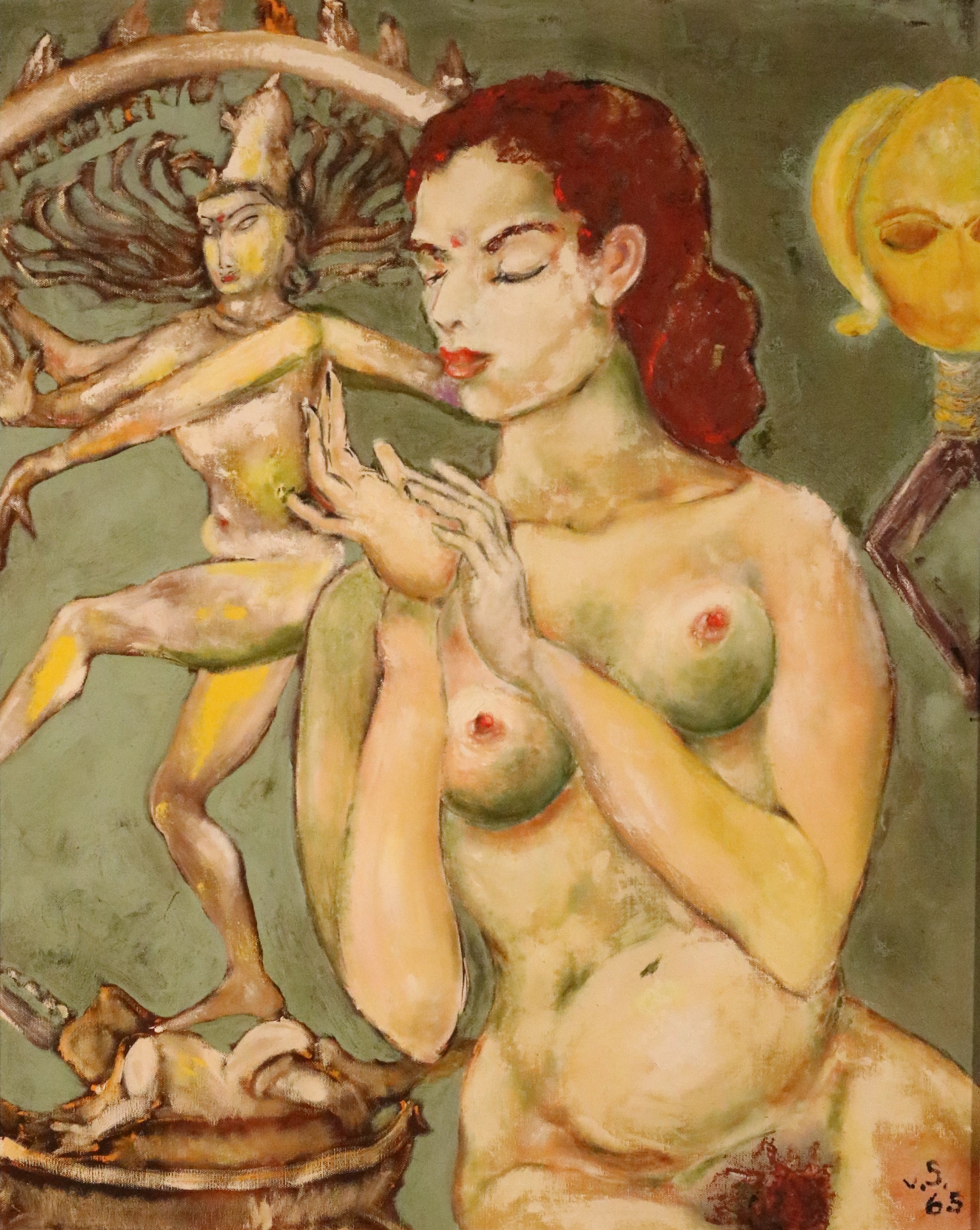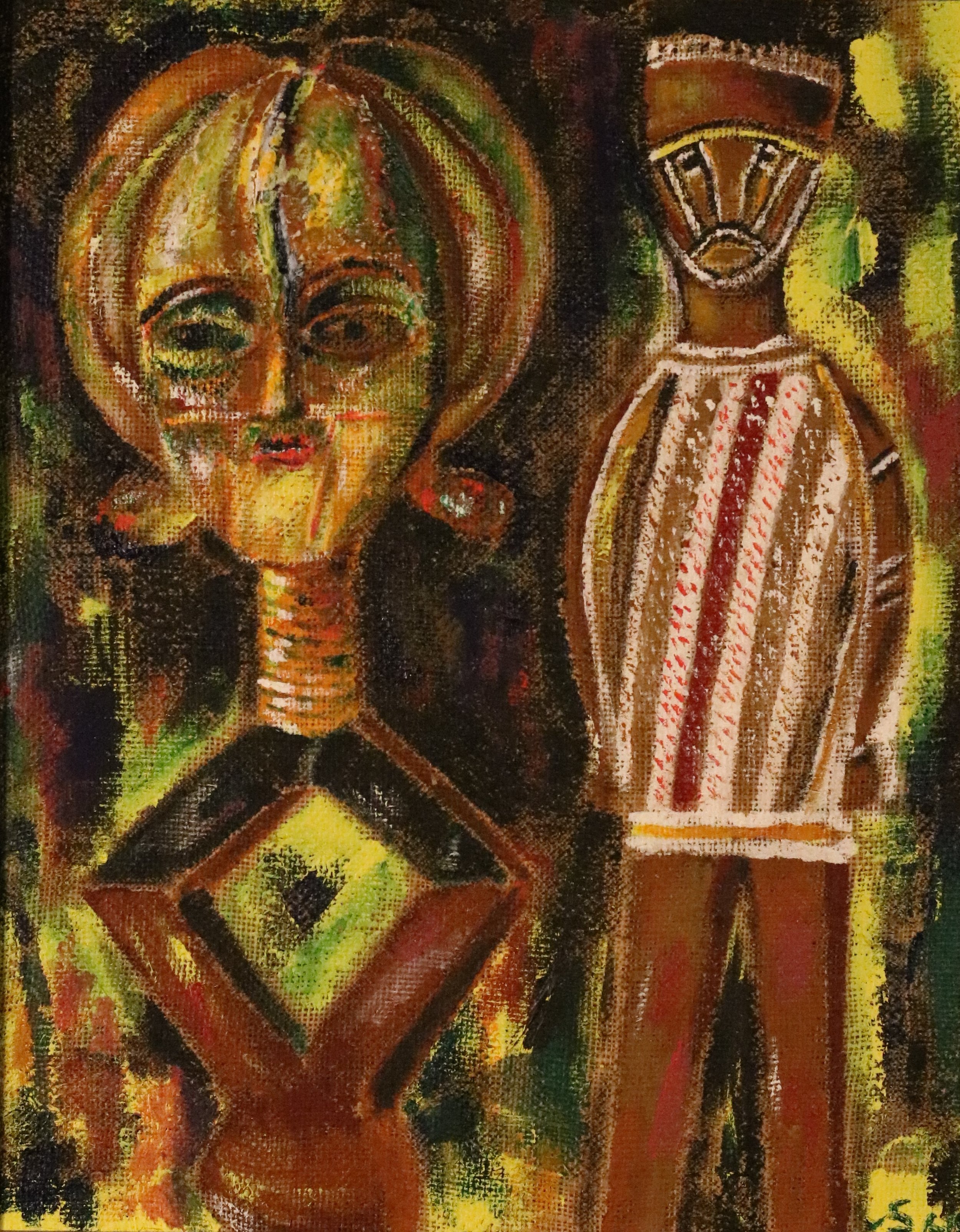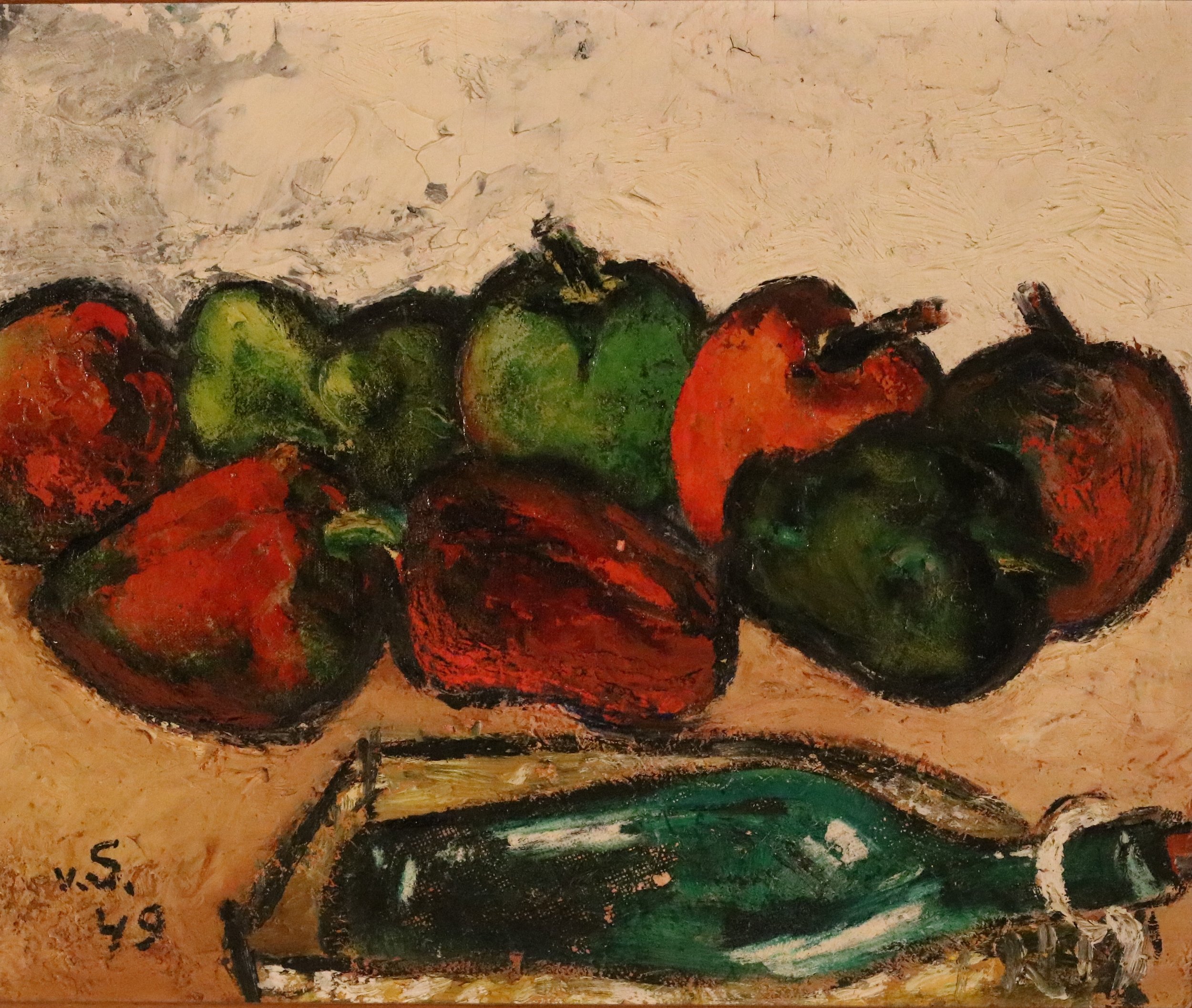Josef von Sternberg
(29 May 1894 Vienna, Austria – 22 December 1969 Hollywood, CA)
Active: Los Angeles, New York, Africa, Japan, Polynesia
Biography from Brady Hart Gallery
Best known as a pioneering film director, Josef von Sternberg was also a painter. An artist in any medium he chose, be it paint, celluloid, or the written word, von Sternberg saw life in terms of art, saw the art in filmmaking, but was well aware that filmmaking was a business, a collaboration, and an exercise in compromise, and that the artistry at the core of the idea was much changed by the time it could be seen by the intended audience.
As a painter, von Sternberg could control the process of creation from the inspiration through to the completion in a way that did evade him, and necessarily evades all directors, in the creation of a film. And so he painted. From the earliest days in his career as a director though to the last days of his life, von Sternberg painted in oil on canvas. Clearly inspired and informed by Cezanne, and by the German Expressionists, and by the Modern movement, Josef von Sternberg created masterful works on canvas that ranged from self-portraits, to landscape views from vistas in his life, still life paintings that do recall Cezanne, portraits of his family members, and iconic paintings he made during his travels in Africa and Japan. He painted a whorehouse in Algiers with the same tender brushstroke that he applied to a Manhattan cityscape view from his house in Weehawken, New Jersey.
Much has been written elsewhere about the fact that von Sternberg created the first independent film, developed entirely new lighting techniques which have become the standard to follow for those that came behind him, and of course the fact the von Sternberg introduced the world to actress Marlene Dietrich. An intensely visual man, von Sternberg painted in light and shadow on the movie screen. He is well known for using textures, props and recurring themes such as feathers and netting to achieve a visual vocabulary that became his trademark look in the world of cinema.
Josef von Sternberg was an avid art collector and an active painter as well throughout his life. His own writings are sprinkled with constant references to the world of art. A consummate collector of fine art, von Sternberg assembled a collection of fine art to appreciate and to be inspired by in his own creative process. His collection included works by Picasso, Van Gogh, Modigliani, Dix, Pechstein, and Belling. Of course film making IS art, a visual medium not entirely distinct from the medium of oil on canvas.
Josef von Sternberg’s paintings and sculpture were twice exhibited alongside his world class collection of artwork, both at Los Angeles County Museum of Art, first in 1935, and again in 1943. In the last year of his life, 1969, Josef found the time to make many paintings, so his catalog includes quite a few paintings from that year. The full catalog of his works may be viewed online, at http://www.bradyhart.com/josef-von-sternberg-summary/
Quotes from “Fun in a Chinese Laundry”, the autobiography of Josef von Sternberg.
p. 1
There is a method made famous by Rorschach whose ten symmetrical inkblots can be used to reveal much that might otherwise be unnoticed. Were enough artists prevailed upon to submit to this test, some specific disorder peculiar only to the artist might then be classified. In the interim the only available symptom is the inkblot the artist himself makes when he creates, and which is often amazingly different from that of others in the field. But somewhere there is a common denominator. There is a marble sculpture by Michelangelo and a head in bronze by an unknown member of the Benin tribe. Both were made about the same time. It is inconceivable that they knew each other, but entirely plausible that both were beset by the same problem. Each dealt with the problem in his own fashion; both performed an act of creation, the same ritual, a sort of prayer as passionate as that of a woman seeking salvation on her knees; with both it was an act of love; both were seeking a bridge to the unknown, and both sought approval from a drive he alone contained. The great Italian and the anonymous Negro were both masters of art.
“Art” is a word which leads into a semantic fog. The dictionaries fumble its meaning, and some propose that it is a skill employed in gratifying taste and in the production of beauty. This is not only incorrect but misleading. “Beauty” and “taste” are slippery words without any known standard, and they may have nothing to do with art.
p.2
Yet, I aspired to the status of an artist in a branch of the arts where it is not permitted to be one. Only in the most isolated instances was it possible to achieve full expression of the urgencies that desired to be projected. Much of my work displayed in the galleries where our enormous audience is lured to view it met with approbation, but I find it difficult to believe that this was due to anything more than the inclusion of paltry notes of appeal and questionable standards. It should not be assumed that values which made for popularity were always injected deliberately; it is far more likely that a lack of ability and the conditions that surrounded the work were responsible. Normally an artist is able to inspect his work before it is seen by others, correct what is unsatisfactory, or destroy it. Of course this is out of the question in my particular medium. So it should not surprise anyone that I rarely, if ever, yielded to a deep sense of outrage when a work of mine was not shown as planned by me or, as sometimes happened, was completely suppressed.
p. 147
“In reading this detail of how an actor gets his mood in order to do a day’s work, one should not lose sight of my attempt to describe not an actor, but a tube of color which must be used to cover my canvas.”
p. 165
“It is unavoidable at this point to repeat that an actor is rewarded with attention out of all proportion to his responsibility. I do not wish to imply that he is paid too much for his services, as this phrase of his reward does not concern me; to delude the masses is always profitable. It is, however important to point out the absurdity of receiving the profits of speculation in emotions, when neither the emotions nor the speculation are the actor’s. Lest this observation be so misleading that it gives rise to the suspicion that I envy the applause an actor receives, this is not so. The painter does not resent the praise received by the colors on his canvas. “This spot of red is wonderful” cannot displease the artist who placed the red in his design. However, there is a slight difference: the spot of red, having been praised, does not vilify the artist. “
p. 177
I was opposed to no method he might think valid for impersonating himself, though I became somewhat suspicious when he became a mystic. Apparently he was attempting to imbue his characterization with meanings that an actor should not attempt to express, intent on soaring into a rarefied air where he could pass Dali, Kandinsky, and Chagall in full flight. He was beginning to mystify not only me; I am certain that Swedenborg and Blake would have been equally confused. To quote James Huneker: “Once , Arthur Symons showing Rodin some Blake drawings told the French sculptor ‘Blake used literally to see those figures; they are not mere inventions.’ ‘ yes’ replied Rodin, ‘he saw them once; he should have seen three or four times.”
Publication information:
Exhibition Catalog, June 16 – July 31, 1935 LACMA, “From the Collection of Josef von Sternberg”
Exhibition Catalog, 1943, LACMA, show title: “The Collection of Josef von Sternberg”
“Art by Film Directors” Karl French and Mitchell Beasley, 2004, Octopus Publishing, 208 pages total, pages 176 – 181 are dedicated to the art of von Sternberg.
3 illustrations of the artist’s paintings in color.
Foreword for the exhibition catalog for the 1935 Exhibition at LACMA:
Few things ever have given me greater pleasure than to be asked to write a short foreword for the exhibition of art, owned by my friend, Mr. Josef von Sternberg. And I might add that nothing has been a source of greater personal pride than to have induced Mr. von Sternberg to consent finally to let the public see his truly remarkable art collection.
Los Angeles has been less happy than most other large American cities in having a group of many discriminating art collectors. Mr. von Sternberg is one of the most notable exceptions. Himself a genius and a sculptor of great talent, he has no trouble in his selection of work by other geniuses. I have only been an ardent admirer of genius and naturally must depend more on rare good luck rather than on any keen artistic foresight.
Los Angeles can call itself most fortunate when Mr. von Sternberg settled in our midst and I now speak not only from the viewpoint of great art for a great city.
In no other way can real art intelligence ever be developed in any community. A few leaders are always needed for pioneer art work. In no other way can a public hungry for art ever hope for art education which eventually must place Los Angeles in a safe, secure position as an art center of world recognized art work.
Chicago, June 1, 1935 Preston Harrison
Quotes from John Baxter - Von Sternberg
Young Jonas shared the streets with geniuses as well as whores. In painting, music, and literature, Vienna represented the cutting edge of artistic experimentation. The group calling itself the Secession had broken with the swirling curlicues of the Franco-Belgian art nouveau and, via artists such as Gustav Klimt and Egon Schiele, entered the territory of sexual imagery and the unconscious pioneered by another Austrian, Sigmund Freud. Von Sternberg is a painter in the narrowest and broadest senses of the world. Von Sternberg’s life in Vienna ended in 1908 when Moses, who became a U.S. citizen in 1906, decided that the family should rejoin him in the United States. He’d found steady work in the clothing business. His naturalization application lists his profession as “furrier,” and the 1910 census as “lace worker.” To signify his commitment to his adoptive home, Moses changed his name to Morris. On their arrival in the United States, Serafin became Serafina, Heinrich was renamed Henry, Hermine became Minna, and Siegfried was known as Fred. Jonas assumed the more common Josef but never liked the diminutive Joe. He always signed himself “Jo,” a reminder of the original. Since Moses was naturalized, the entire family automatically acquired U.S. citizenship. (pg.15)
Once the New York Public Library opened in 1911, he spent most of his spare time there. A classic autodidact, he read almost entirely to inform himself. Fiction didn’t figure in his curriculum, which favored philosophy, history, and particularly art. On February 17, 1913, an International Exhibition of Modern Art opened in the Sixty-ninth Regiment Armory on New York’s Lexington Avenue. Mounted by the Association of American Painters and Sculptors, it aimed to demonstrate that local artists deserved comparison with the best in Europe. Many of the 300 artists who contributed 1,250 paintings and sculptures to the Armory Show, as it became known, were U.S.-based, including George Bellows, Mary Cassatt, Childe Hassam, Edward Hopper, and James McNeill Whistler. Others were Europeans exhibiting in the United States for the first time. They included Wassily Kansinsky, Pablo Picasso, Paul Cezanne, and Marcel Duchamp, whose Nude Descending a Staircase fascinated artists but aroused derision in the papers. Four thousand people attended on the first day, and von Sternberg was among them. “That was an enormous influence on him,” said Meri von Sternberg, his third wife, “and [he] often talked about what he saw there.” He returned frequently, indifferent to the furor. He was already developing a taste that would lead him to sketch and paint-not very successfully- and experiment with still photographs. Later, he amassed one of Hollywood’s finest collections of modern art and commissioned new works, including portraits of himself by David Alfaro Siqueiros, Rudolf Belling, and Boris Deutsch. Jesse Lasky Jr. wrote “he was always saving himself from oblivion with the immortalizing attentions of sculptures and painters. One could frequently find him posing in his office while developing one of his scripts.” This i8s an exaggeration, although he did allow Siqueiros to observe him at work to create some preliminary sketches for his portrait. (pgs. 16 & 17)
Other visitors to the set included an attractive Russian émigré Sculptor Dora Gordine, who became a friend in Hollywood, and the artist George Grosz. He and von Sternberg had already me in the studio of Rudolf Belling, who was sculpting a portrait head of the director, later cast in bronze. Shortly after, Belling, Grosz, and von Sternberg were guests at dinner with dealer Alfred Flechtheim. When Belling asked if film directing was lucrative, von Sternberg replied, “I don’t really earn a great deal; not quite three times as much as the President of the United States.” Grosz was less impressed by the sum than by the fact that, as von Sternberg dropped his bombshell, he didn’t even look up to see the effect. Suddenly this quiet-spoken little man became interesting, inspiring Grosz to devote part of his memoirs to “Svengali Joe,” as a Berlin journalist had christened him. (Nor did he exaggerate. Until 1949, the president received $75,000 a year. Von Sternberg, at $20,000 a week, was substantially better recompensed.) (pg. 116 & 117)
Rudolf Arnheim, “Once again we experience a primitive plot being used as an opportunity to create an enchanted sea of light, a supernatural magic world. We think we are seeing not likeness of real objects but a painter’s fantasies of blackness and lightness all run together. Shadows hang over the figures, over the locomotive; Marlene Dietrich’s face is crosshatched by a black veil, and when the machine takes on water at the station, the mysterious back pipe between the clouds of steam resembles a ghost.” (pg. 143)
In Chicago, during the delay between the arrival of the Twentieth Century from New York and the departure of the Superchief for Los Angeles, von Sternberg visited an art gallery to purchase Georg Grosz’s 1924 watercolor Married Couple. In what appears to be a hotel room, a nude woman washes herself with a cloth while a man, suspenders dangling, stands on a balcony with his back to her, smoking. That they have just had sex is clearly implied, and the mirror on the wall behind the woman, hanging crookedly, suggests that it was violent- or, more likely, titled by them, the better to watch themselves. Few pictures are more emblematic of von Sternberg’s sexuality or so singularly appropriate to the film he was about to make. (pg. 156)
With time on his hands, von Sternberg took refuge in art, organizing an exhibition of his collection at the Los Angeles County Museum. Urged by Preston Harrison, a prominent collector and donor, the museum devoted most of its wall space in June and July to forty three oils, fifty-five watercolors and drawings, and thirty-five sculptures. Along with works by Modigliani, Picasso, Pascin, Kandinsky, Nolde, Vlaminck, Dix, Grosz, Archipenko, and Kokoschka, the show included most of the self-portraits first displayed on the set during the making of Blonde Venus, plus work by von Sternberg protégés Peter Ballbusch and Peter Kollorsz and paintings of his own so fresh that it was initially too wet to hang. The Los Angeles Times reviewed the show respectfully, remarking that von Sternberg’s choice of art, like his films, could “aggravate some people” but that both showed “ the same flair for bold adventuring in the realm of plastic form, color and movement.” (pg. 193)
Meri von Sternberg recalled, “Jo had taken me to Crown Heights, Brooklyn, and a few other places, to see if I would like to live there. Finally we went across the Hudson to Weehawken, New Jersey. When I saw the Palisades, I was stunned. We took up residence in a house overlooking the Hudson on Kingswood Road in Weehawken.” The two- story house was a new one, built to von Sternberg’s specifications. To pay for it, he sold his art collection. A total of 107 items went under the hammer at Parke-Bernet, New York, on November 22, 1949, raising more than $100,000. His first and only child, Nicholas, was born in January 1951, while the house was still under construction. Von Sternberg had an ulterior motive in relocating. (pg. 247)
Exhibition Information:
1943, LACMA, show title: “The Collection of Josef von Sternberg”
(paintings)
53. Sketch of Honfleur
54. Trees
55. Portrait
(Sculpture)
90. Torso
June 16 – July 31, 1935 LACMA, “From the Collection of Josef von Sternberg”
(Painting)
43. Study
(Sculpture)
35. Torso
Foreword for the exhibition catalog for the 1943 Exhibition at LACMA:
HASTY NOTE TO THE VISITOR…
It seems to me that all the arts, or for that matter, all spiritual values can function only in the degree in which we bring them deepness of feeling and understanding.
A place of warship is meaningless unless there is someone to pray. The book is nothing unless it be read. A museum is a mockery unless there are students. Science is gibberish except when mastered.
I know that many of you will ask contemptuously what I can bring to all this, and yet, if you will be gentle with your division, and remember that the artist has not done his work for you but because of his own need for clarity of purpose as painstakingly done it for himself, that art does not float by itself in time and space, but is a true reflection of both; if you remember that the artist may have needed bread for his body and food for his soul; that he is rarely pleased with his work, and in the case of genius, never, then perhaps you will bring enough to carry away in exchange something that will help to put in order your own particular brand of chaos, and form your own pattern of beauty without which life is only vegetation.
In my case, Responsible as I am for this collection, and though I have seen better in journeys around the earth, many of the things I eagerly gathered no longer speak to me. There are a few that still do because I have not lost my ability to speak to them, and because in addition to great craftsmanship, intellectual integrity, and creative power I see such a wonderfully simple things, available to all of us, such as patients, faith, encourage, and in every possible, Reverend urge to love the world and its people.
STERNBERG
















































